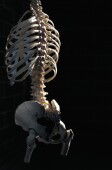
FRIDAY, Sept. 14 (HealthDay News) — Alcoholics who stop drinking and engage in physical activity can help reverse bone loss suffered as a result of their addiction, according to a new study.
Bone renews itself through a continual remodeling process, which excessive alcohol consumption disrupts. Austrian researchers found that avoiding alcohol for just eight weeks can help correct the imbalance between bone formation and resorption that results from alcoholism. Exercise also can help protect against reduced bone mineral density, they said.
The study appears online Sept. 14 in advance of print publication in the December issue of the journal Alcoholism: Clinical & Experimental Research.
“This study contributes to our understanding of various deteriorating effects of long-term consumption of high amounts of alcohol on the human body,” Sergei Mechtcheriakov, associate professor of psychiatry at the Medical University Innsbruck, said in a journal news release.
“We can see that even bone tissue, which is often wrongly perceived as inert, can be affected by alcoholism,” he said. “It would seem that a combination of direct toxic effects of alcohol and its metabolites on bone tissue turnover — as well as lifestyle factors, such as low physical activity — may play a significant role.”
In conducting the study, 53 men in rehab for alcoholism underwent bone-density tests. The participants, who were between ages 21 and 50, had blood drawn when the study began and again after eight weeks of treatment. They also completed a questionnaire on how much physical activity they got before they began treatment.
“We found that [bone mineral density] is reduced in alcoholic men without liver disease,” Peter Malik, the study’s corresponding author and a senior scientist and physician at the university, said in the news release. “However, the initial imbalance between bone formation and resorption seems to straighten out during abstinence.”
For people without the bone-thinning disease osteoporosis, this means an increased fracture risk could be reduced during abstinence, Malik explained.
“In addition, regular physical exercise seems to be ‘bone protective’ in alcoholic patients, likely due to the fact that a dynamic strain on bone through physical activity increases the rate of bone formation and resorption, which is good for bone density,” he said.
The researchers pointed out, however, that bone metabolism is improved in the first weeks of recovery, but not fully restored.
“Recovery after long-term alcoholism takes months and probably years,” Mechtcheriakov said. “We need better understanding of these processes in order to be able to conceive better rehabilitation programs.”
This study supports the view that treatment programs should contain long-term moderate physical activity regimens, he said.
“But the study also suggests that deficits in the musculoskeletal system, such as [bone mineral density] reduction or muscular atrophy, should be taken into account during the rehabilitation,” Mechtcheriakov added.
The study’s authors advised that patients with a long history of alcoholism undergo dual-energy X-ray absorptiometry, a measurement of bone mineral density. They noted that this is particularly important if the patients smoke or have other risk factors for bone loss.
More information
The U.S. National Institutes of Health Osteoporosis and Related Bone Diseases National Resource Center provides more information on alcoholism and bone health.

